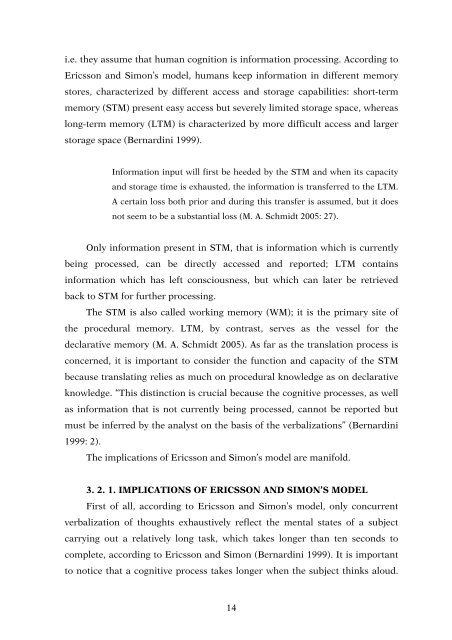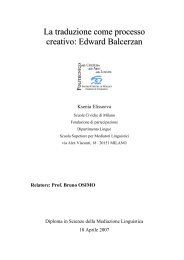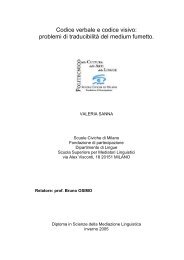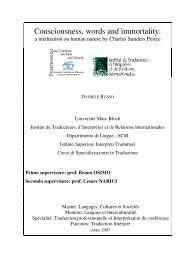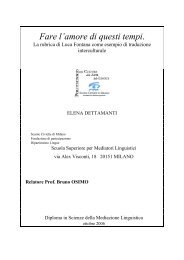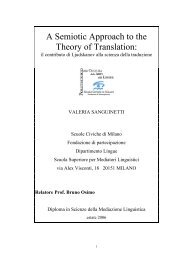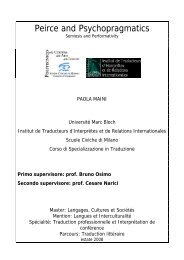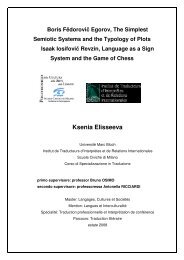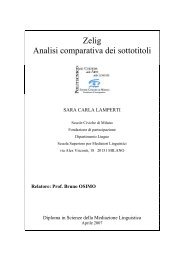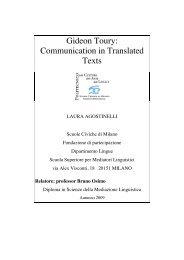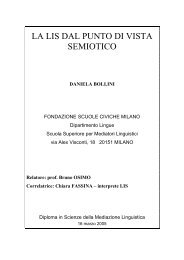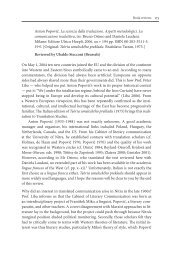Relatore: Professor Bruno OSIMO - Bruno Osimo, traduzioni ...
Relatore: Professor Bruno OSIMO - Bruno Osimo, traduzioni ...
Relatore: Professor Bruno OSIMO - Bruno Osimo, traduzioni ...
Create successful ePaper yourself
Turn your PDF publications into a flip-book with our unique Google optimized e-Paper software.
i.e. they assume that human cognition is information processing. According to<br />
Ericsson and Simon’s model, humans keep information in different memory<br />
stores, characterized by different access and storage capabilities: short-term<br />
memory (STM) present easy access but severely limited storage space, whereas<br />
long-term memory (LTM) is characterized by more difficult access and larger<br />
storage space (Bernardini 1999).<br />
Information input will first be heeded by the STM and when its capacity<br />
and storage time is exhausted, the information is transferred to the LTM.<br />
A certain loss both prior and during this transfer is assumed, but it does<br />
not seem to be a substantial loss (M. A. Schmidt 2005: 27).<br />
Only information present in STM, that is information which is currently<br />
being processed, can be directly accessed and reported; LTM contains<br />
information which has left consciousness, but which can later be retrieved<br />
back to STM for further processing.<br />
The STM is also called working memory (WM); it is the primary site of<br />
the procedural memory. LTM, by contrast, serves as the vessel for the<br />
declarative memory (M. A. Schmidt 2005). As far as the translation process is<br />
concerned, it is important to consider the function and capacity of the STM<br />
because translating relies as much on procedural knowledge as on declarative<br />
knowledge. “This distinction is crucial because the cognitive processes, as well<br />
as information that is not currently being processed, cannot be reported but<br />
must be inferred by the analyst on the basis of the verbalizations” (Bernardini<br />
1999: 2).<br />
The implications of Ericsson and Simon’s model are manifold.<br />
3. 2. 1. IMPLICATIONS OF ERICSSON AND SIMON’S MODEL<br />
First of all, according to Ericsson and Simon’s model, only concurrent<br />
verbalization of thoughts exhaustively reflect the mental states of a subject<br />
carrying out a relatively long task, which takes longer than ten seconds to<br />
complete, according to Ericsson and Simon (Bernardini 1999). It is important<br />
to notice that a cognitive process takes longer when the subject thinks aloud.<br />
14


